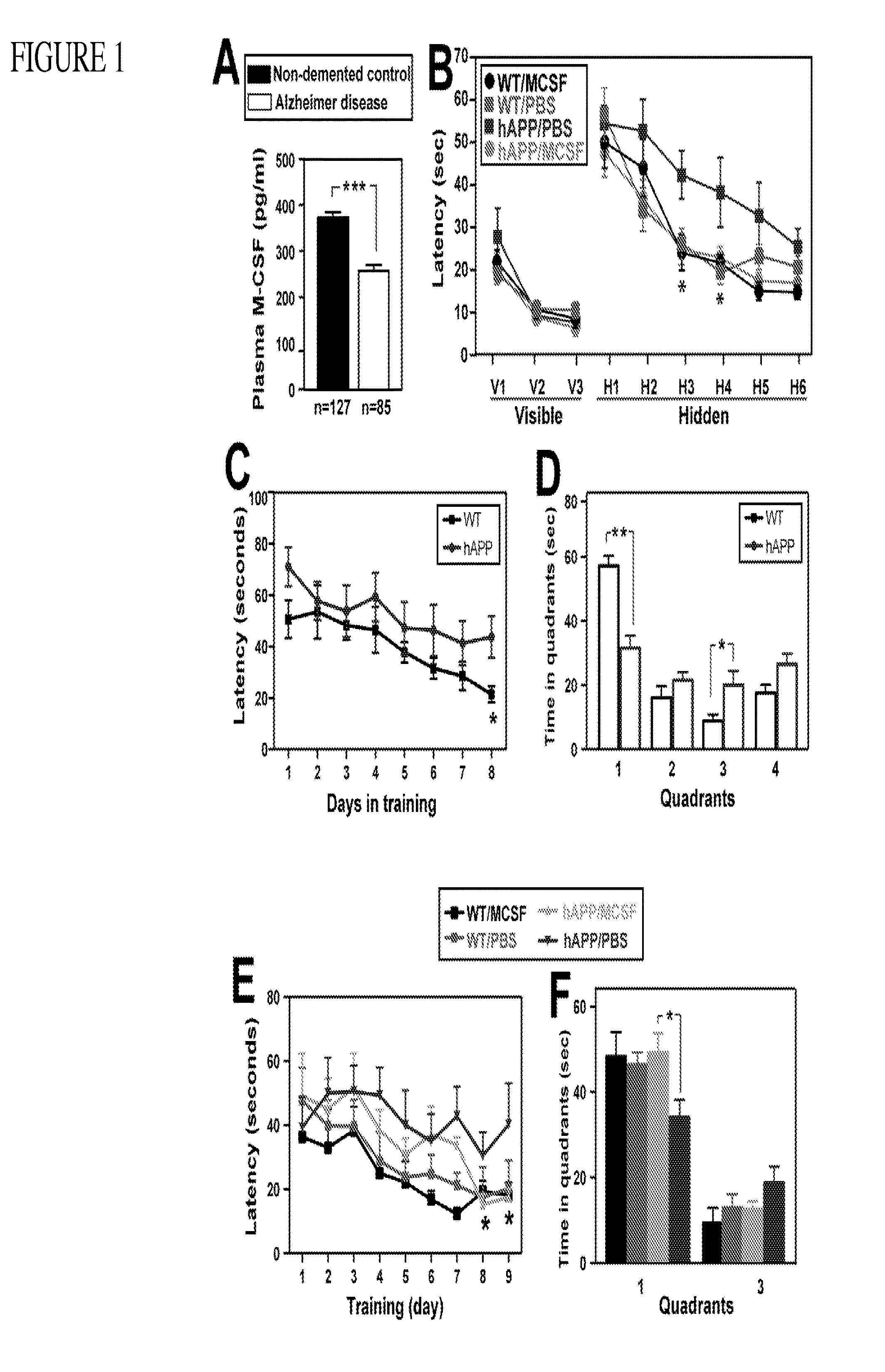Methods of neuroprotection involving macrophage colony stimulating factor receptor agonists
a macrophage colony and receptor agonist technology, applied in the direction of drug compositions, peptide/protein ingredients, cardiovascular disorders, etc., can solve the problems of acute injury or degeneration of neurons, major cause of mortality and morbidity, permanent neurological damage, etc., to reduce neuronal damage, stimulate neuronal repair, and attenuate neuronal damage
- Summary
- Abstract
- Description
- Claims
- Application Information
AI Technical Summary
Benefits of technology
Problems solved by technology
Method used
Image
Examples
example 1
Systemic Administration of Macrophage-Colony Stimulating Factor (M-CSF) Improves Cognitive Function in hAPP-Transgenic Mice, Independent of Aβ Pathology
[0121]In earlier studies, the inventors of the present invention had observed a decreased concentration of macrophage-colony stimulating factor (M-CSF) in plasma from subjects suffering from Alzheimer's disease (‘AD plasma’) in comparison to plasma from healthy control subjects (‘control plasma’). This observation, in combination with differential concentrations of other signaling proteins in AD plasma versus control plasma can be used to diagnose Alzheimer's disease (Ray et al., 2007). In more recent studies, consistent with these findings, subjects suffering from AD were found to exhibit significantly lower plasma levels of M-CSF than age-matched, healthy control subjects (see FIG. 1A), indicating a peripheral deficiency of M-CSF in subjects suffering from AD.
[0122]To investigate in an animal model of Alzheimer's disease the effect...
example 2
Systemic Administration of M-CSF Reduces Kainic Acid-Induced Neurodegeneration
[0125]To explore whether systemically administered M-CSF exerts protective effects on neurons, M-CSF was administered systemically in a mouse model of kainic acid-induced neurodegeneration. Subcutaneous administration of kainic acid (20 mg / kg) into wildtype FVB / N mice resulted in severe seizures (highest seizure score 6.4±1.3), with significant degeneration of neurons in the pyramidal layer (FIG. 3A) and reduced hippocampal calbindin immunoreactivity (FIG. 3C) upon postmortem pathological examination, consistent with previous reports (Luo et al., 2006). In contrast, wildtype FVB mice injected intraperitoneally with recombinant, human M-CSF (800 μg / kg body weight) 24 h prior to kainic acid administration showed little hippocampal cell loss (see FIG. 3A / B) and calbindin reduction (see FIG. 3C / D), although they suffered from similar seizure activity (highest seizure score 6.2±1.7). In line with these findings...
example 3
M-CSF Inhibits Kainic Acid-Induced Microgliosis
[0126]Glial cells are non-neuronal cells that surround and insulate neurons from one another, supply oxygen and nutrients to neurons, destroy pathogens and remove dead neurons.
[0127]Microglia are the smallest of the glial cells and are generally considered the resident macrophages of the brain and the spinal cord, acting as the first form of active immune defense in the central nervous system. Microglial cells can become activated by a single stimulus such as neuron damage, lipopolysaccharide or kainic acid administration, and in response release neurotoxic factors, including tumor necrosis factor-a, nitric oxide, interleukin-1β, and reactive oxygen species that all drive progressive neuron damage (Lull & Block, 2010); this is known as reactive microgliosis.
[0128]Glial cells are sensitive to neuronal dysfunction and damage, and markers associated with activation of microglia are frequently used as indicators of neuronal injury and neuro...
PUM
 Login to View More
Login to View More Abstract
Description
Claims
Application Information
 Login to View More
Login to View More - R&D
- Intellectual Property
- Life Sciences
- Materials
- Tech Scout
- Unparalleled Data Quality
- Higher Quality Content
- 60% Fewer Hallucinations
Browse by: Latest US Patents, China's latest patents, Technical Efficacy Thesaurus, Application Domain, Technology Topic, Popular Technical Reports.
© 2025 PatSnap. All rights reserved.Legal|Privacy policy|Modern Slavery Act Transparency Statement|Sitemap|About US| Contact US: help@patsnap.com



